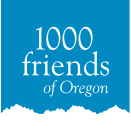On April 30th, 2020, 1000 Friends — in coalition with other organizations — sent the Land Conservation & Development Commission and the Oregon Department of Transportation letters recommending they use their current legal authority to treat climate change as a crisis and implement plans to reduce carbon emissions via Oregon’s #1 carbon-producing sector; transportation.
As reported by ODOT, the state will reduce transportation emissions by only 20% by 2050 under the current trajectory, a far cry from the state’s adopted GHG reduction goal of a 75% reduction in total emissions across all sectors by 2050.
Both agencies were directed by Governor Kate Brown in September 2019 (well before her executive order on climate) to take action to meet Oregon’s GHG emission goals— yet there has been little progress.
Land use ties directly into the reduction of GHG emissions: metropolitan areas that promote mixed-use development, more housing located near walking, transit, and bicycling options, and the ability for residents to utilize other methods of transportation besides driving will be a critical factor in meeting Oregon’s carbon reduction targets.
Below are just a few highlights of our recommendations:
- “LCDC must act now to amend its Transportation Planning Rule (TPR) to require the state's other seven metropolitan areas to do what Portland Metro has already done: adopt long-range transportation and land use plans that meet state-adopted GHG reduction targets.”
- “Rulemaking should include: A public engagement plan that leads with the communities most impacted by climate change in the state’s urban areas: lower-income communities, communities of color, older persons, the transit-dependent, youth, and those whose health is impacted by climate pollution.”
- “In short, implementing the STS (state transportation strategy) and achieving our GHG goals requires a fundamental shift in the way Oregon meets transportation needs in metropolitan areas - from our current approach that emphasizes roadway expansion and SOV (single occupancy vehicle) travel, to a new approach that promotes compact mixed use development and a range of safe, affordable, accessible transportation options - walking, cycling, transit, ridesharing.”
